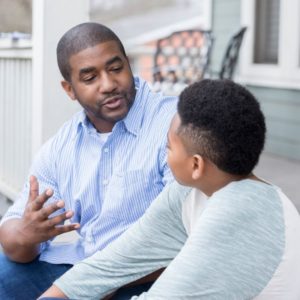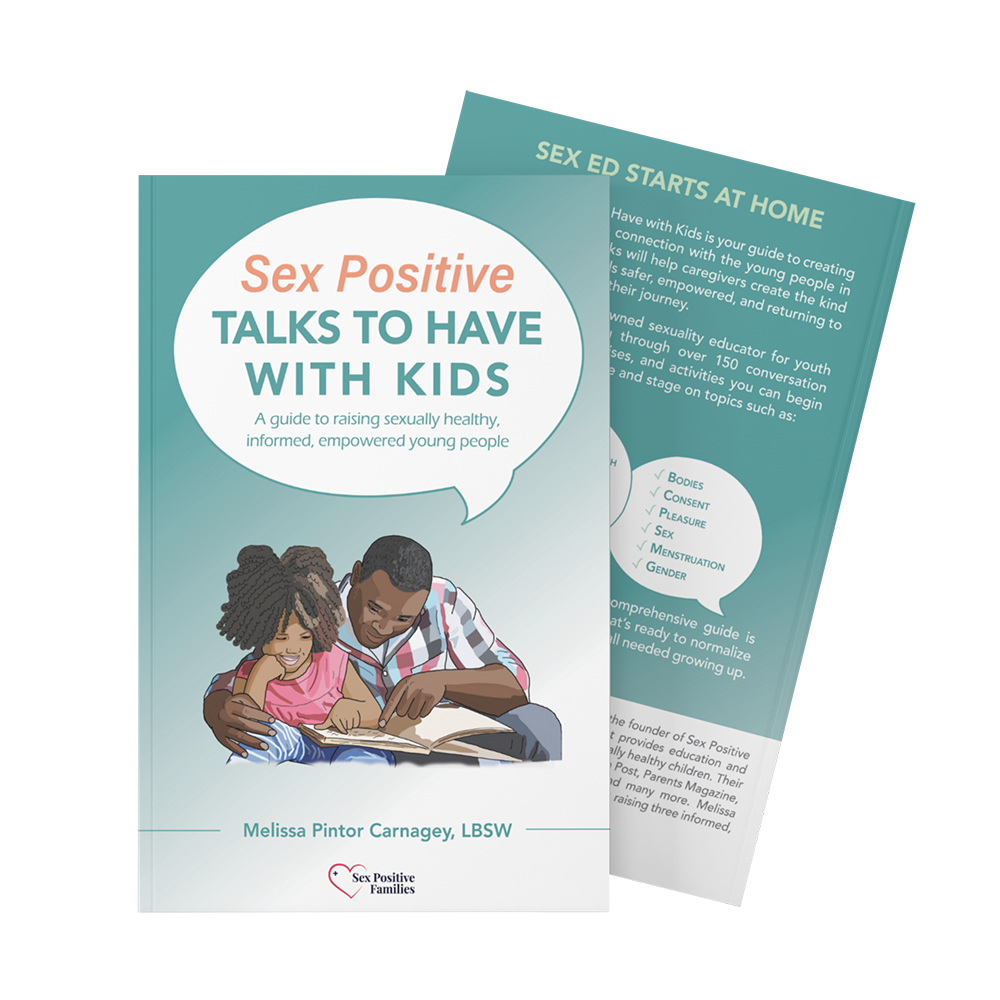– By: Melissa Pintor Carnagey, LBSW –
Some of the toughest questions parents receive from their child aren’t about subjects like algebra or geography.
They’re about sex– What is it? How do you do it? Who has sex? How do you know if you’re ready for it?
These curiosities are completely typical within childhood and adolescence, and they offer amazing opportunities for a trusted adult and young person to connect. That said, the topic of sex is one that few caregivers feel totally prepared and confident to tackle, which is common because many adults of today:
- received poor-to-no sex education growing up
- have trauma experiences that can make anything related to sex or bodies feel triggering
- are living in a sex negative society where sex is taboo
- grew up without open, sex positive talks at home
For these reasons, becoming more comfortable answering the real questions can take practice. Like a muscle, it needs to be flexed and strengthened. So it is perfectly normal if you’re feeling hesitation or wondering if this topic is “age-appropriate” to discuss with your child. Just keep in mind, if a young person is asking, they deserve an answer. Silence or avoidance only hinders trust and sends them a message that you are not someone they can turn to with their curiosities. And contrary to what some may think, the goal of sex talks with young people isn’t to provide a tutorial or to scare them away from understanding this very human experience, it’s a chance to build upon a foundation of their sexual health.
By showing up for these conversations, you send them the message that you are a trusted resource for honest, shame-free talks along their path.

To better support you in tackling talks with young people about sex, here are six responses that are shame-free, accurate, and inclusive:
“That’s a great question! I’m so glad you’re asking. What have you heard about sex? What do you think it means?”
Affirming their curiousness, and trust in you as a resource, is always a first response within sex positive homes. The next option can actually be a question that can clue you into what your child may have heard or experienced before and can ensure that you get a very clear picture of the context of their curiosity. Their answers can also offer you the opportunity to clear up any misconceptions or misinformation they may have about sex.
Our favorite foundational and inclusive books to check out together are What Makes a Baby and Sex is a Funny Word, both by Cory Silverberg.
“Sex is an activity that adults, and some older teens who feel ready, can do. Sometimes just for pleasure and sometimes to make babies.”
It’s honest, inclusive, and matter-of-fact. In this response, you’re sending them several important messages:
- sex is not something children do, which is important to be clear about for safety talks. As you will see in the next response, sex must involve consent, and children are not able to consent to sex, so that’s a key distinction that you want to make here.
- sexual readiness is individual. This is an opportunity to talk about the responsibility that comes up when making the decision to have sex with another person.
- pleasure is essential to the experience. This is key to supporting a safer, more positive understanding of sex, versus the fear or shame-based explanation many of us received.
- not all sex leads to reproduction, which is an inclusive fact. (And if you’d like sex positive answers to kids’ questions about reproduction, check out this previous article: Five Sex Positive Answers to “Where do babies come from?”)
Parents can anxiously assume that questions about sex are all about mechanics or the anatomy involved, and that’s not always the case. Follow their questions and trust in your ability to be present for them. Any answer you’re unsure of, just be honest. Say, “That’s a great question! I’m honestly not sure how to answer that. I’m going to look that up and get back to you.” Then actually do. You can also take the opportunity to look information up together. Resources like AMAZE Jr for younger ages, AMAZE for tweens, and Scarleteen for teens all offer reliable, inclusive, and positive education about sexual health.
Knowing every answer to your child’s questions is not the goal. Being a trusted, shame-free adult is.
“Sex should always involve consent, communication, trust, and it should feel good and safe to the people involved.”
This answer gives you the opportunity to explore the ingredients that make up healthy, safer sexual experiences. Feel free to edit this statement in the ways that feel true to your understanding or that include your family’s values. What’s ideal is that your young person walks away without misconceptions that can lead to risky experimentation. We want them to feel aware and prepared for their future sexual decision making. This ultimately keeps them less vulnerable to abusive or unsafe dynamics. It also prepares their lens for more accurately interpreting sexualized media or online porn they could come across, which often does not show healthy examples of sex.

“Not everyone chooses to have sex, and there are different ways people can have sex.”
This response hits the mark for inclusivity, which is important in not making assumptions about your young person’s sexual identity. Youth deserve to know that it is “normal” if they or another person does not want to have sex. Assuming that every other teen is doing it, is often what leads young people to try sex before they feel ready, simply to “fit in.” The truth is, most young people and many adults are not having sex, so young people need to hear that that’s perfectly normal.
The fact that sex isn’t just vaginas receiving penises is an important truth that too often is avoided in the talks. To get this right, let’s be clear that sexual activity shouldn’t be gendered. There’s no such thing as “gay sex” or “straight sex.” It’s simply sex– bodies in pleasure. How those bodies choose to explore their pleasure individually and collectively is what makes up the experience. When young people are aware of this, they can enter into sexual decision making with greater confidence, care, and understanding of how to stay safer. This awareness also keeps them correctly informed. Young people need to know that pregnancy does not occur via anal or oral sex, and that sex between people with the same parts or gender is not wrong or impossible. Inclusive sex talks also can open up conversations about how to minimize pregnancy or STI transmission.
“If consent is not involved, then it is not sex. It would be called rape, sexual abuse, or sexual assault, which is a crime.”
One thing we can do differently for the next generation, is raise them with a clear understanding of consent. Many adults of today were not provided the education that could have kept them safer and without inflicting or experiencing trauma. When we distinguish the difference between sex and abuse it is easier to identify safe and unsafe touch, how to disclose harm, and the signs of abusive relationships or situations. And as mentioned earlier, children cannot have sex because a child is not old enough to provide informed consent. Though genital exploration between kids, and even acts that mimic adult sexual activity, are common, this is not the same as sex. If you’re interested in understanding how to talk about and respond to genital play that can happen between kids, check out this previous article: How to Respond to Genital Play Between Kids.
“Being curious about bodies and sex is completely normal. I know a resource that can help you learn more about this. Let’s check it out together!”
The best thing we can do is normalize our child’s experiences, including their curiosities. When young people worry that they will be criticized or punished for wondering about taboo topics, they go silent and turn to less trustworthy sources like Google, peers, or PornHub. Showing up for these talks is not about knowing all of the answers or following a script. It’s about being a reliable, shame-free touchstone.
Thankfully, our generation of parents have so many fun, engaging, inclusive, sex positive resources to learn about these topics with our children. Whether your child likes to learn through watching a video, listening to a podcast made for families, playing a game, or reading a book, we have an ever expanding resources list with age-congruent options perfect for talks at every age and stage.
Raising sexually healthy children means not shying away from curiosities, no matter how uncomfortable we may feel discussing anatomy, reproduction, and sex, or how awkward the words (initially) may sound coming from our mouths. Self-compassion is important as you work toward growing in confidence about addressing these curiosities in more honest and comfortable ways.
Practice is your friend! If you want to feel super prepared, you can imagine yourself having this conversation before it happens and practice saying the words out loud. This can help to calm your discomfort, and make words related to bodies, sex, and identity more familiar and less awkward.
If your answers are honest and your demeanor relaxed and confident, you are laying the groundwork for the kids in your life to feel comfortable continuing to come back to you with their questions and curiosities, without shame or fear.
 For a guide made just for parents and caregivers to tackle sexual health talks at every age and stage, check out our bestselling book Sex Positive Talks to Have With Kids: A guide to raising sexually healthy, informed, empowered young people.
For a guide made just for parents and caregivers to tackle sexual health talks at every age and stage, check out our bestselling book Sex Positive Talks to Have With Kids: A guide to raising sexually healthy, informed, empowered young people.

Sex Positive Talks to Have With Kids is the bestselling guide to creating an open, shame-free connection with the young people in your world.
It’s an inclusive, medically accurate, and comprehensive resource that walks you through over 150 conversation starters, reflection exercises, and activities you can begin implementing at every age and stage to normalize sexual health talks and become the trusted adult we all needed growing up.
